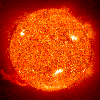 |
||
| First page | ||
 |
||
| Composition | ||
 |
||
| Activity | ||
 |
||
| The Sun as a star | ||
 |
||
| How/Why study? | ||
 |
Importance for us | |
 |
||
| Find out more | ||
 |
||
 |
||
Many scientists around the world turn telescopes and satellites toward the Sun in order to be able to understand our nearest star. For centuries different civilisations have depended on the Sun for heat and light to live. However, the Sun effects the Earth in more ways than enabling us to keep warm and grow food.
The most famous effect is the Aurora and it can be seen around the polar latitudes when the upper atmosphere becomes excited by energetic electrons from the storms on the Sun. When the Earth's environment is affected by activity from the Sun we call it a geomagnetic storm and variations in the Earth's magnetic field occur.
The number of sunspots on the Sun follows the solar cycle, but in the 17th century a strange event happened where during a period of 70 years from 1640 to 1710 almost no sunspots were observed. British astronomer E. Walter Maunder realised that this period coincided with an absence of the aurorae on the Earth. It has also been recorded that the Earth suffered a slight decrease in temperature during this time and colder weather ensued. Northern Europe went through a period now known as the Little Ice Age. Both are results of changes in the activity level of the Sun.
Today the Sun affects our lives in many more ways as we utilize current technology. Hundreds of satellites orbit the Earth, both for scientific and commercial uses and events from the Sun affect their performance. Low energy particles from the Sun can charge up the surface of the satellite, and when these events discharge they cause damage to surface materials and interfere with electrical devices. More energetic particles can travel through the surface of the satellite and damage the instruments inside. Solar flares produce many highly energetic protons which can reach the Earth in 30 minutes. . During a geomagnetic storm the Earth's atmosphere gets heated and an increased drag on the satellites is felt. With this extra resistance the spacecraft slow down and lose altitude, they could quite literally drop out of the sky!! To compensate for this manouvers must be carried out by the satellite to re-adjust it's orbit back to a stable one.
Reasons for studying the Sun stretch far out into space aswell. It is our nearest star and its proximity provides heat and light to maintain life on Earth, as well as being aunique laboratory to test our theories of the evolution of other stars and the formation of galaxies. On the Sun we are able to resolve features and study physical processes in a way that is impossible with more distant stars and astrophysical objects. Solar studies have enabled us to determine that other stars also have spots and hot coronae.
Astronauts who orbit outside of the earth's atmosphere can be exposed to large doses of radiation during a large solar storm. Even with their eyes shut the energetic particles hit their retina and cause sparkles of light! Passengers flying in commerical jets at high latitudes in the atmosphere are also exposed to higher radiation levels.
10th September 2000
Lucie Green
Sarah Amandusson
www_astro@mssl.ucl.ac.uk